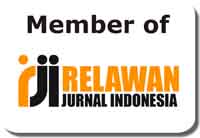Translation and Semantic Shift of Islamic Vocabulary in English Abstracts: A Corpus-Based Study at an Indonesian Islamic University
Abstract
Keywords
Full Text:
PDFReferences
Akbarian, I. H., Ghanbarzadeh, Z., & Afzali Shahri, M. (2017). Profiling vocabulary in psychology journal abstracts: A comparison between Iranian and Anglo-American journals. Iranian Journal of Language Teaching Research, 5(1), 51-69.
Al Farisi, M. Z. (2023). Acceptability of the Quran Translation. Al-Jami'ah: Journal of Islamic Studies, 61(2), 329-363.
Anis, M. Y., Nababan, M., Santosa, R. & Mohammad Masrukhi (2022) The ideology behind the translation of an Islamic moral ethic book: A case study of Al-Ḥikam’s aphorisms, Cogent Arts & Humanities, 9:1, 2129484, DOI: 10.1080/23311983.2022.2129484
Anthony, L. (2013). A critical look at software tools in corpus linguistics * 1, 30(2), 141–161.
Anthony, L. (2014b). AntWordProfiler. Tokyo, Japan: Waseda University. Retrieved from http://www.antlab.sci.waseda.ac.jp/
Hassan, I., Azmi, M.N., & Abubakar, U. (2017). The Use of Terminology in Reporting Islam: A Comparative Analysis. International Journal of English Linguistics, 7, 236.
Baalbaki, R. (1998). A Modern Arabic-English Dictionary. Beirut: Dar el Ilm Lilmalayin
Badawi, El-Said M.; Haleem, M. A. Abdel (2008), Arabic-English dictionary of Qur'anic usage, Brill Academic Publishers
Brown, A. (1996). The Treatment of Religious Terminology in English Dictionaries. In R. M. Asraf (Ed.), English and Islam: Creative Encounters 96 (pp. 307–314). Malaysia: Department of English Language and Literature, International Islamic University Malaysia.
Clark, V. L. P., Creswell, J. W., Green, D. O. N., & Shope, R. J. (2008). Mixing quantitative and qualitative approaches. Handbook of emergent methods, 363, 363-387.
Choi, J., & Kim, K. H. (2021). Translating Islamic Knowledge for the New Soil: Two Korean Translations of the Qur’an in South Korea. Interventions, 23(7), 973–996. https://doi.org/10.1080/1369801X.2020.1863837
Coxhead, A. (2000). A New Academic Word List. TESOL Quarterly, 34(2), 213–238.
Dakakke, M.M. (2022) Qur’anic terminology, translation, and the Islamic conception of religion, Religion, 49:3, 343-363, DOI: 10.1080/0048721X.2019.1622837
Dhona, H. R. (2024). Islamic communication as an invention of modern-western knowledge: critical analysis toward Islamic communication in Indonesia. Asian Journal of Communication, 34(3), 381–398. https://doi.org/10.1080/01292986.2024.2320902
Doyle, D., no year. Indonesian Stopword. https://www.ranks.nl/stopwords/indonesian
Embabi, D. (2021). Islamic feminism and the renegotiation of new knowledge through translation. Translation Studies, 15(1), 21–36. https://doi.org/10.1080/14781700.2021.1927817
Erlina, D., Mayuni, I., & Akhadiah, S. (2016). Whole language-based English reading materials. International Journal of Applied Linguistics and English Literature, 5(3), 46-56.
Gunawan, F. (2022). The ideology of translators in Quranic translation: lessons learned from Indonesia. Cogent Arts & Humanities, 9(1). https://doi.org/10.1080/23311983.2022.2088438
Giampieri, P. (2020). Volcanic experiences: comparing non-corpus-based translations with corpus-based translations in translation training. Perspectives, 29(1), 46–63. https://doi.org/10.1080/0907676X.2019.1705361
Hassan, S. (2016). Islamic religious terms in English–translation vs. transliteration in Ezzeddin Ibrahim and Denys Johnson-Davies’ translation of An-Nawawī’s Forty Ḥadīths. Translation & Interpreting, 8(1), 117–132. https://doi.org/10.12807/ti.108201.2016.a08
Hussin, M., & Kamal, M. H. (2021). Translation of al-Quran into Malay Language in the Malay World. IJISH (International Journal of Islamic Studies and Humanities), 4(1), 32–50. https://doi.org/10.26555/ijish.v4i1.3322Kwary, D. A., & Artha, A. F. (2017). The Academic Article Word List for Social Sciences 1. Mextesol Journal, 41(4), 1–11.
Molina, L. & Hurtado Albir, A. (2002). Translation Techniques Revisited: A Dynamic and Functionalist Approach. Meta, 47(4), 498–512. https://doi.org/10.7202/008033ar
Nafis, Ph.D., M. Cholil (2011). Teori Hukum Ekonomi Syariah. Penerbit Universitas Indonesia. hlm. 17. ISBN 9789794564561.
Nation, I. S. P. (2001). Learning Vocabulary in another Language (First). Cambridge: Cambridge University Press.
Nugraha, I. S., Sujatna, E. T., & Mahdi, S. (2021). Corpus linguistic study of tweets using# charliehebdo hashtag. JALL (Journal of Applied Linguistics and Literacy), 5(1), 54-70.
Nurbayan, Y. (2019). Metaphors in the Quran and its translation accuracy in Indonesian. Indonesian Journal of Applied Linguistics, 8(3), 710-715.
Marín Pérez, M. J., & Almela Sánchez-Lafuente, Á. (2022). The representation of migrants in Spanish judicial decisions: using corpus data to refute hate speech.
Masrai, A., & Milton, J. (2021). Vocabulary knowledge and academic achievement revisited: General and academic vocabulary as determinant factors. Southern African Linguistics and Applied Language Studies, 39(3), 282–294. https://doi.org/10.2989/16073614.2021.1942097
Rizal, Efri Arsyad, and Mohamad Sobirin. “Translating the Transcends of God’s World in the Arabic-Quran into Balinese”. ESENSIA: Jurnal Ilmu-Ilmu Ushuluddin 22, no. 1 (May 29, 2021): 63–75. Accessed June 23, 2024.
Sutarsyah, C, Nation, P. & Kennedy, G. (1994) How useful is EAP Vocabulary for ESP? A Corpus-Based Study. RELC Journal, 25 (2), 34-50
Shihab, M. Q. (2020) Kosakata Keagamaan: Makna dan Penggunaannya.PT Lentera Hati: Tangerang
Simbuka, S., Hamied, F. A., Sundayana, W., & Kwary, D. A. (2019). A Corpus-Based Study on the Technical Vocabulary of Islamic Religious Studies. TEFLIN Journal: A Publication on the Teaching & Learning of English, 30(1).
Simbuka, S. (2021). Evaluating the Vocabulary Coverage of EFL Textbooks and Teachers’ Generated Materials in an Indonesian Islamic Universities: A Corpus-Informed Materials Evaluation. AL-ISHLAH: Jurnal Pendidikan, 13(3), 2489-2500.
Tottoli, R. (2023). The Qur’an in Europe, A European Qur’an: A History of Reading, Translation, Polemical Confrontation and Scholarly Appreciation. Jurnal Studi Ilmu-Ilmu Al-Qur’an Dan Hadis, 24(2), 285–336. https://doi.org/10.14421/qh.v24i2.4738
Üstün Külük, S. (2023). Translating Islam(ism) for a Muslim society: a novel ‘Intra-Ummah translation paradigm’ for Islamist translations in Turkey. Perspectives, 1–15. https://doi.org/10.1080/0907676X.2023.2281969
West, M. (1953). A general service list of English words: with semantic frequencies and a supplementary word-list for the writing of popular science and technology. London: Longman, Green & Co.
Yuliawati, S., & Ekawati, D. (2023) Sketching women: A corpus analysis of woman representation in the Sundanese magazine Manglé (1958-2019). Indonesian Journal of Applied Linguistics, 13(1), 173-182.
DOI: http://dx.doi.org/10.31332/lkw.v0i0.8326
Copyright (c) 2024 Misbahuddin Jamal, Srifani Simbuka

This work is licensed under a Creative Commons Attribution-ShareAlike 4.0 International License.
Langkawi: Journal of The Association for Arabic and English indexed by:


















.png)
.png)

.png)
2.png)








